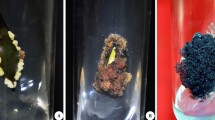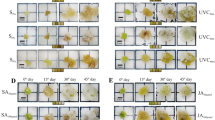Abstract
Plants are the unique sources of secondary metabolites (terpenes, phenolic and alkaloid) used as pharmaceuticals, food additives and industrial produces. However, very limited information is known about their biosynthesis in plants. Elicitors are chemicals often used to activate the accumulation of such metabolites in plant in vitro cultures. Since the ancient past, Narcissus is well-known for its ornamental purposes and medicinal versatility with diverse pharmaceutically important alkaloids including galanthamine, lycorine, haemanthamine and narciclasine. In this research, callus cultures induced from N. pseudonarcissus cv. Carlton bulb explants were subjected to MS media supplemented with growth regulators, yeast extract, methyl jasmonate, chitosan and trans-cinnamic acid for the determination of galanthamine content using GC-MS. Bulbs showed 538 to 1109 μg g−1 FW (fresh weight), and callus cultures subjected to MS medium without elicitors produced 7.88 μg g−1 FW of galanthamine, whereas callus cultures grown on MS with methyl jasmonate, chitosan and 25% sucrose showed approximately 5.6-, 3- and 2-fold increased galanthamine production respectively. NMR (nuclear magnetic resonance) depicted that the concentrations of metabolites related to galanthamine production, tyrosine, tyramine, and 3-chlorotyrosine were higher in bulb tissue than callus. However, these metabolites were present in higher concentrations in elicitor-treated calluses, leading to the higher galanthamine accumulation than the non-treated calluses. Furthermore, the notable metabolites detected in elicitor-treated callus cultures were amino acids, phenols and sugar alcohols. The metabolites in media extracts were mainly related to sucrose and galactose metabolism. The results suggested that the application of elicitors could be a potential approach for enhanced production of valuable metabolites in Narcissus in vitro culture.






Similar content being viewed by others
References
Bastida J, Lavilla R, Viladomat F (2006) Chemical and biological aspects of Narcissus alkaloids. Alkaloids Chem Biol 63:87–179
Bergoñón S, Codina C, Bastida J, Viladomat F, Melé E (1996) Galanthamine production in “shoot-clump” cultures of Narcissus confusus in liquid-shake medium. Plant Cell Tiss Org Cult 45:191–199
Berkov S, Bastida J, Viladomat F, Codina C (2011) Development and validation of a GC–MS method for rapid determination of galanthamine in Leucojum aestivum and Narcissus ssp.: a metabolomic approach. Talanta 83:1455–1465
Berkov S, Ivanov I, Georgiev V, Codina C, Pavlov A (2014) Galanthamine biosynthesis in plant in vitro systems. Eng in Life Sci 14:643–650
Blanc G, Lardet L, Martin A, Jacob J, Carron M (2002) Differential carbohydrate metabolism conducts morphogenesis in embryogenic callus of Hevea brasiliensis (Müll. Arg.). J Exp Bot 53:1453–1462
Codina C (2002) 7 Production of galanthamine by Narcissus tissues in vitro. Narcissus and Daffodil (The Genus Narcissus). Taylor & Francis, London
Colque R, Viladomat F, Bastida J, Codina C (2004) Improved production of galanthamine and related alkaloids by methyl jasmonate in Narcissus confusus shoot-clumps. Planta Med 70:1180–1188
Dias MI, Sousa MJ, Alves RC, Ferreira IC (2016) Exploring plant tissue culture to improve the production of phenolic compounds: a review. Ind Crop Prod 82:9–22
El Tahchy A, Ptak A, Boisbrun M, Barre E, Guillou C, Dupire FO, Chrétien FO, Henry M, Chapleur Y, Laurain-Mattar D (2011) Kinetic study of the rearrangement of deuterium-labeled 4′-O-methylnorbelladine in Leucojum aestivum shoot cultures by mass spectrometry. Influence of precursor feeding on Amaryllidaceae alkaloid accumulation. J Nat Prod 74:2356–2361
Ferdausi A, Chang X, Hall A, Jones M (2020) Galanthamine production in tissue culture and metabolomic study on Amaryllidaceae alkaloids in Narcissus pseudonarcissus cv. Carlton Ind Crops Prod 144:112058
Georgiev V, Berkov S, Georgiev M, Burrus M, Codina C, Bastida J, Ilieva M, Pavlov (2009) Optimized nutrient medium for galanthamine production in Leucojum aestivum L. in vitro shoot system. Zeitschrift für Naturforschung C 64:219–224
Giri L, Dhyani P, Rawat S, Bhatt ID, Nandi SK, Rawal RS, Pande V (2012) In vitro production of phenolic compounds and antioxidant activity in callus suspension cultures of Habenaria edgeworthii: a rare Himalayan medicinal orchid. Ind Crop Prod 39:1–6
Isah T, Umar S, Mujib A, Sharma MP, Rajasekharan PE, Zafar N, Frukh A (2018) Secondary metabolism of pharmaceuticals in the plant in vitro cultures: strategies, approaches, and limitations to achieving higher yield. Plant Cell Tiss Org Cult 132:239–265
Ivanov I, Georgiev V, Pavlov A (2013) Elicitation of galanthamine biosynthesis by Leucojum aestivum liquid shoot cultures. J Plant Physiol 170:1122–1129
Karuppusamy S (2009) A review on trends in production of secondary metabolites from higher plants by in vitro tissue, organ and cell cultures. J Med Plants Res 3:1222–1239
Kilgore MB, Kutchan TM (2016) The Amaryllidaceae alkaloids: biosynthesis and methods for enzyme discovery. Phytochem Rev 15:317–337
Kim HK, Choi YH, Verpoorte R (2010) NMR-based metabolomic analysis of plants. Nat Protoc 5:536–549
Kim HK, Choi YH, Verpoorte R (2011) NMR-based plant metabolomics: where do we stand, where do we go? Trends Biotech 29:267–275
Lubbe A, Gude H, Verpoorte R, Choi YH (2013) Seasonal accumulation of major alkaloids in organs of pharmaceutical crop Narcissus Carlton. Phytochem 88:43–53
Lubbe A, Verpoorte R, Choi YH (2012) Effects of fungicides on galanthamine and metabolite profiles in Narcissus bulbs. Plant Physiol Biochem 58:116–123
Mahmud I, Shrestha B, Boroujerdi A, Chowdhury K (2015) NMR-based metabolomics profile comparisons to distinguish between embryogenic and non-embryogenic callus tissue of sugarcane at the biochemical level. In Vitro Cell Dev Biol - Plant 51:340–349
Mahmud I, Thapaliya M, Boroujerd IA, Chowdhury K (2014) NMR-based metabolomics study of the biochemical relationship between sugarcane callus tissues and their respective nutrient culture media. Anal Bioanal Chem 406:5997–6005
Molnár Z, Virág E, Ordog V (2011) Natural substances in tissue culture media of higher plants. Acta Biolog Szegediensis 55:123–127
Murashige T, Skoog F (1962) A revised medium for rapid growth and bioassays with tobacco cultures. Plant Physiol 15:473–497
Nalawade SM, Tsay HS (2004) In vitro propagation of some important Chinese medicinal plants and their sustainable usage. In Vitro Cell Dev Biol - Plant 40:143–154
Namdeo A (2007) Plant cell elicitation for production of secondary metabolites: a review. Pharm Rev 1:69–79
Oksman-Caldentey KM, Saito K (2005) Integrating genomics and metabolomics for engineering plant metabolic pathways. Curr Opin Biotechnol 16:174–179
Osorio EJ, Berkov S, Brun R, Codina C, Viladomat F, Cabezas F, Bastida J (2010) In vitro antiprotozoal activity of alkaloids from Phaedranassa dubia (Amaryllidaceae). Phytochem Lett 3:161–163
Palama TL, Menard P, Fock I, Choi YH, Bourdon E, Govinden-Soulange J, Bahut M, Payet B, Verpoorte R, Kodja H (2010) Shoot differentiation from protocorm callus cultures of Vanilla planifolia (Orchidaceae): proteomic and metabolic responses at early stage. BMC Plant Biol 10:1
Ptak A, El Tahchy A, Dupire F, Boisbrun M, Henry M, Chapleur Y, Mos M, Laurain-Mattar D (2008) LCMS and GCMS for the screening of alkaloids in natural and in vitro extracts of Leucojum aestivum. J Nat Prod 72:142–147
Ramirez-Estrada K, Vidal-Limon H, Hidalgo D, Moyano E, Golenioswki M, Cusidó RM, Palazon J (2016) Elicitation, an effective strategy for the biotechnological production of bioactive high-added value compounds in plant cell factories. Molecules 21:182
Rivero RM, Mestre TC, Mittler R, Rubio F, Garcia-Sanchez F, Martinez V (2014) The combined effect of salinity and heat reveals a specific physiological, biochemical and molecular response in tomato plants. Plant Cell Env 37:1059–1073
Saliba S, Ptak A, Laurain-Mattar D (2015) 4′-O-Methylnorbelladine feeding enhances galanthamine and lycorine production by Leucojum aestivum L. shoot cultures. Eng Life Sci 15:640–645
Schripsema J (2010) Application of NMR in plant metabolomics: techniques, problems and prospects. Phytochem Anal 21:14–21
Schumann A, Berkov S, Claus D, Gerth A, Bastida J, Codina C (2012) Production of galanthamine by Leucojum aestivum shoots grown in different bioreactor systems. Appl Biochem Biotech 167:1907–1920
Schumann A, Torras-Claveria L, Berkov S, Claus D, Gerth A, Bastida J, Codina C (2013) Elicitation of galanthamine production by Leucojum aestivum shoots grown in temporary immersion system. Biotech Prog 29:311–318
Szlávik L, Gyuris Á, Minárovit SJ, Forgo P, Molnár J, Hohmann J (2004) Alkaloids from Leucojum vernum and antiretroviral activity of Amaryllidaceae alkaloids. Planta Med 70:871–873
Tahchy AE, Boisbrun M, Ptak A, Dupire F, Chrétien F, Henry M, Chapleur Y, Laurain-Mattar D (2010) New method for the study of Amaryllidaceae alkaloid biosynthesis using biotransformation of deuterium-labeled precursor in tissue cultures. Acta Biochim Polon 57:75–82
Takos AM, Rook F (2013) Towards a molecular understanding of the biosynthesis of amaryllidaceae alkaloids in support of their expanding medical use. Int J Mol Sci 14:11713–11741
Taleb AMA, Hamed ER, Shimaa AZ, Adel B (2013) Enhancement of alkaloids production in tissue culture of Narcissus tazetta var. italicus I: effect of growth regulators and fungal elicitors. J Agric Tech 9:503–514
Tasseva G, Richard L, Zachowski A (2004) Regulation of phosphatidylcholine biosynthesis under salt stress involves choline kinases in Arabidopsis thaliana. FEBS Lett 566:115–120
Torras-Claveria L, Berkov S, CodinaC VF, Bastida J (2013) Daffodils as potential crops of galanthamine. Assessment of more than 100 ornamental varieties for their alkaloid content and acetylcholinesterase inhibitory activity. Ind Crop Prod 43:237–244
Van Der Kooy F, Maltese F, Choi YH, Kim HK, Verpoorte R (2009) Quality control of herbal material and phytopharmaceuticals with MS and NMR based metabolic fingerprinting. Planta Med 75:763–775
Xia J, Wishart DS (2010) MetPA: a web-based metabolomics tool for pathway analysis and visualization. Bioinformatics 26:2342–2344
Xia J, Sinelnikov IV, Han B, Wishart DS (2015) MetaboAnalyst 3.0—making metabolomics more meaningful. Nuc Acid Res 43:251–257
Yang SO, Kim SH, Kim Y, Kim HS, Chun YJ, Choi HK (2009) Metabolic discrimination of Catharanthus roseus calli according to their relative locations using 1H-NMR and principal component analysis. Biosci Biotechnol Biochem 73:2032–2036
Zhao N, Wang G, Norris A, Chen X, Chen F (2013) Studying plant secondary metabolism in the age of genomics. Crit Rev Plant Sci 32:369–382
Zhi HJ, Qin XM, Sun HF, Zhang LZ, Guo XQ, Li ZY (2012) Metabolic fingerprinting of Tussilago farfara L. using 1H-NMR spectroscopy and multivariate data analysis. Phytochem Anal 23:492–501
Acknowledgements
The authors wish to thank Mark Preston, Centre of Proteome Analysis, for helping with GC-MS analysis and Dr. Phelan Marie, NMR Centre, University of Liverpool, for helping with NMR analysis.
Author contribution statement
MJ and AF conceived and designed research. AF conducted experiments. XC and AF developed the methodology, and analysed and interpreted data. AF wrote the initial manuscript draft which was reviewed by XC. All authors read and approved the manuscript.
Funding
The study was financially supported by the Commonwealth Scholarship Commission and University of Liverpool, UK.
Author information
Authors and Affiliations
Corresponding author
Additional information
Editor: David Duncan
Supplementary Information
ESM 1
(DOCX 29 kb)
Rights and permissions
About this article
Cite this article
Ferdausi, A., Chang, X. & Jones, M. Enhancement of galanthamine production through elicitation and NMR-based metabolite profiling in Narcissus pseudonarcissus cv. Carlton in vitro callus cultures. In Vitro Cell.Dev.Biol.-Plant 57, 435–446 (2021). https://doi.org/10.1007/s11627-020-10139-z
Received:
Accepted:
Published:
Issue Date:
DOI: https://doi.org/10.1007/s11627-020-10139-z




